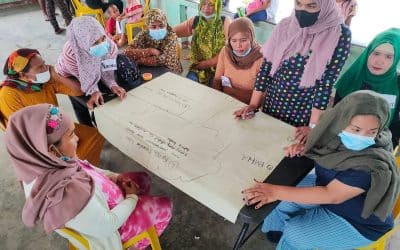InAsia
Insights and Analysis
Q&A: Understanding India’s Cash Crisis
February 1, 2017

Proponents of the cash ban say that it will bring more people into the banking system, increase the number of taxpayers, and reduce corruption. Opponents argue that only a small fraction of India’s untaxed income is held in cash, and that the ban unfairly burdens the poor and women. What are your thoughts on this?
Demonetization was a one-time measure taken under the assumption that people who held their illegal wealth in cash would not be able to launder the money given the government’s surprise announcement and that at least 20 percent of the banned notes would not return to the banking system. When notes are demonetized and remain outside of the banking system beyond a convertibility deadline, central banks can reduce that amount from their total liability. This then surfaces as profit in the central bank’s profit-and-loss account. This income could then be reinvested in worthier public causes such as infrastructure projects and cash transfers to the poor. That, of course, did not happen; almost all of the banned notes are now back in the banking system. In that sense the opponents are correct.
But we won’t know more until we get to see next year’s tax data, roughly 15 months from now. Demonetization is neither an anti-corruption tool nor does it have the policy teeth to affect systemic, long-term reform in the economy. If reducing corruption in the system was the intent, demonetization would have to be accompanied by other anti-corruption measures including reforms in public procurement, tax assessment, and transparency laws that reduce rent-seeking behaviors in government procedures. This may be in the pipeline but there have been no such announcements so far.

Following Modi’s currency ban announcement, Indians were met with long lines at ATMs to withdraw money. Photo/Flickr user Monito www.monito.com
On the other hand, the brunt of demonetization on those who held large amounts of wealth in cash or even those who have remained outside of the banking system with small savings stashed away in a pillow cover has been significant. This experience may lead to some behavior change across the system and more individuals may choose to come into the formal economy and banking system, which will help to expand the tax net. But it is difficult to predict exactly how deep the shock therapy has reached.
At the first of the year, you predicted in this blog that India’s demonetization drive is likely to backfire in 2017 in “unexpected ways.” How so?
We are now approaching the 90-day mark since demonetization and the withdrawal limits in the banks have not been lifted. You still cannot withdraw more that 24,000 rupees ($365) per week from personal accounts. For the average Indian, that is a lot of money, but for the consuming class, which drives India’s economy (Indian economy is around 60 percent private consumption), that represents a suppression of purchasing power. Unlike cash, which can be termed black (money that is illegally obtained or not declared for tax purposes) or white (money earned legally and taxed) on the basis of legality, purchasing power in an economy has no color and more is always better.
December sales figures in key industries such as automobiles, travel and tourism, airlines, and consumer durables are down by about 20 percent. This influences consumer confidence, a key measure of forward-looking economic health for all consumption-heavy economies. Similar effects are being felt in real estate, downstream supply chains of the formal economy in small-and medium-scale industries, and perhaps most importantly, the agricultural sector. While agriculture occupies only a 14 percent share of the Indian economy, a disruption in the farm sector could have a negative effect on the over 800 million people who are still directly or indirectly linked to farm incomes. On January 16, the IMF cut India’s growth rate by 1 percent based on data from the early stages of demonetization. If the net effect of demonetization does indeed stop around there, that would be good news. My sense, however, is that the multiplier effects of a three-month-long cash scarcity will not just result in a marginal cut in growth rate. The full story is yet to unfold.
India is one of the most cash-dependent countries in the world, with over 90 percent of transactions in cash, and more than half of Indians still don’t have a bank account. How is this reality playing in the current crisis? At the same time, digital financial transactions out of necessity are booming, more than many experts expected. Could there be a silver lining in all of this in moving toward a cashless economy?
My earlier comment on the “unexpected” impacts comes precisely out of this concern. India’s economy is heavily cash-based and a replacement regime cannot be installed in a jiffy. While the government is sincerely trying to push digital transactions, this transformation is years away, not months. There was a surge in digital transactions in urban areas following demonetization, but that effect appears to have plateaued out with more cash being injected into the system. This indicates that people still prefer cash and their faith in digital transactions needs a longer cultivation time. Then there is the question of infrastructure and transaction costs. Because of scale economies, internet, banking fees, and digital transaction fees are lower in the populated urban centers. In smaller towns and rural areas where 70 percent of Indians live and work, internet connectively and reliability, at an affordable price, is still years away. Even at higher costs, internet services and infrastructure outside of the major urban centers still do not provide the kind of system reliability one needs for financial transactions. While we can expect a gradual increase in digital transactions if the cash crisis stays on longer, in a normal India where every ATM has ready cash to dispense, a cashless economy stands less of a chance.
As India heads into elections in five key states starting on February 4, how do you see the rupee ban weighing on voting decisions?
Indian elections, particularly at the state level, never quite become a single-issue election. Caste alliances, religion, performance of the incumbent, the viabilities of political coalitions contesting elections, and indeed campaign funds matter in significant ways. That said, the state elections this time around will be seen against a backdrop of demonetization. After almost three months of desperate efforts to contain the impact of demonetization on the average citizen and not quite succeeding, I think there still may be an even split among supporters and opponents of demonetization. When it was announced in November, there was overwhelming support for the move. The poor, no doubt, have been hit the worst, but demonetization is not what made them poor in the first place. That differentiation between an episodic hit on their livelihood versus sustained political grievances of other varieties will be made at the polls, and demonetization will be an issue but not the most determining issue.
The views and opinions expressed here are those of the interviewee and not those of The Asia Foundation or its funders.
About our blog, InAsia
InAsia is posted and distributed every other Wednesday evening, Pacific Time. If you have any questions, please send an email to [email protected].
Contact
For questions about InAsia, or for our cross-post and re-use policy, please send an email to [email protected].The Asia Foundation
465 California St., 9th Floor
San Francisco, CA 94104
The Latest Across Asia
Program Snapshot
May 2, 2024
News
April 25, 2024

2024 Lotus Leadership Awards
The Lotus Leadership Awards recognize contributions towards gender equality in Asia and the Pacific







0 Comments